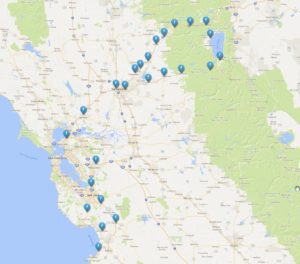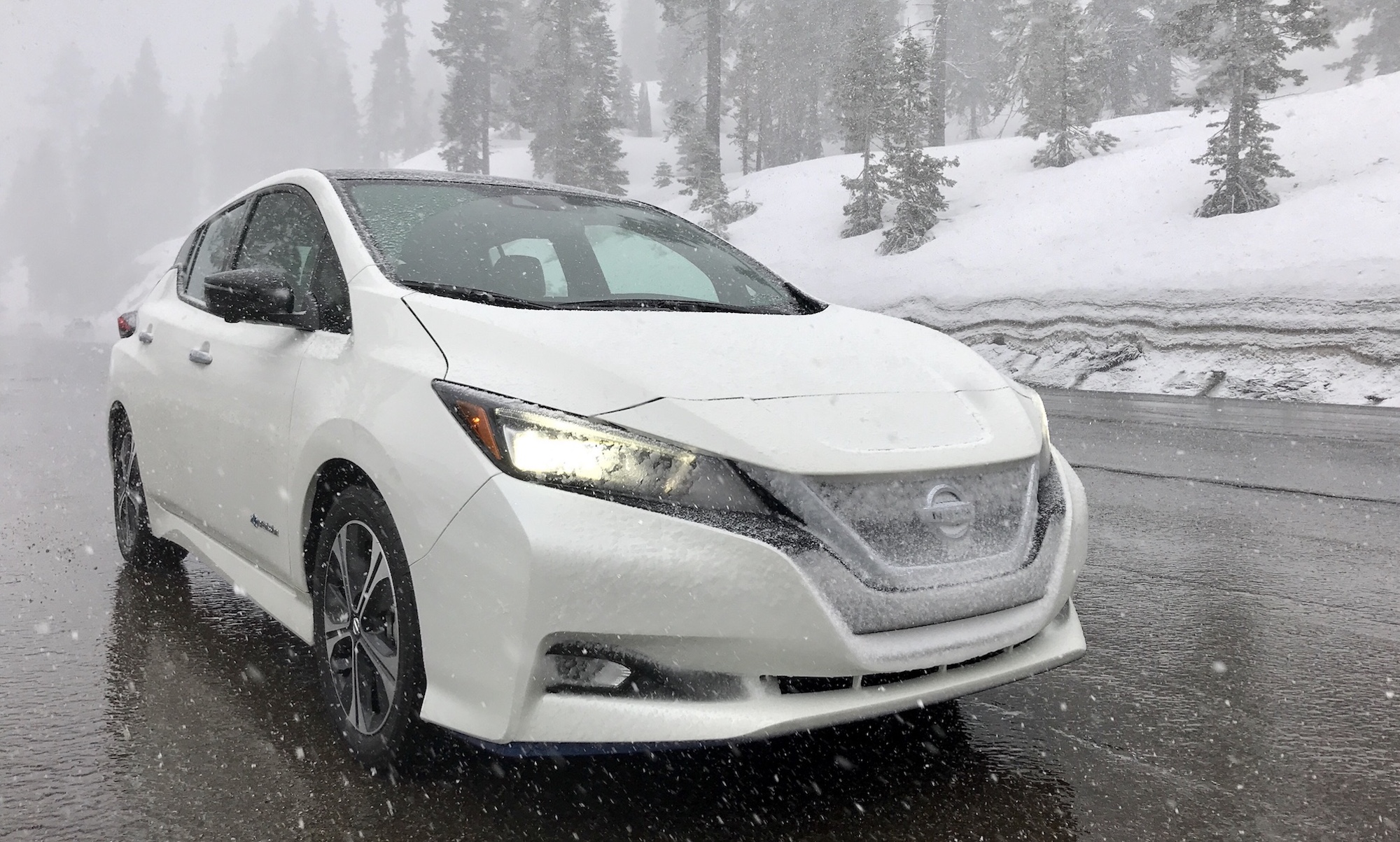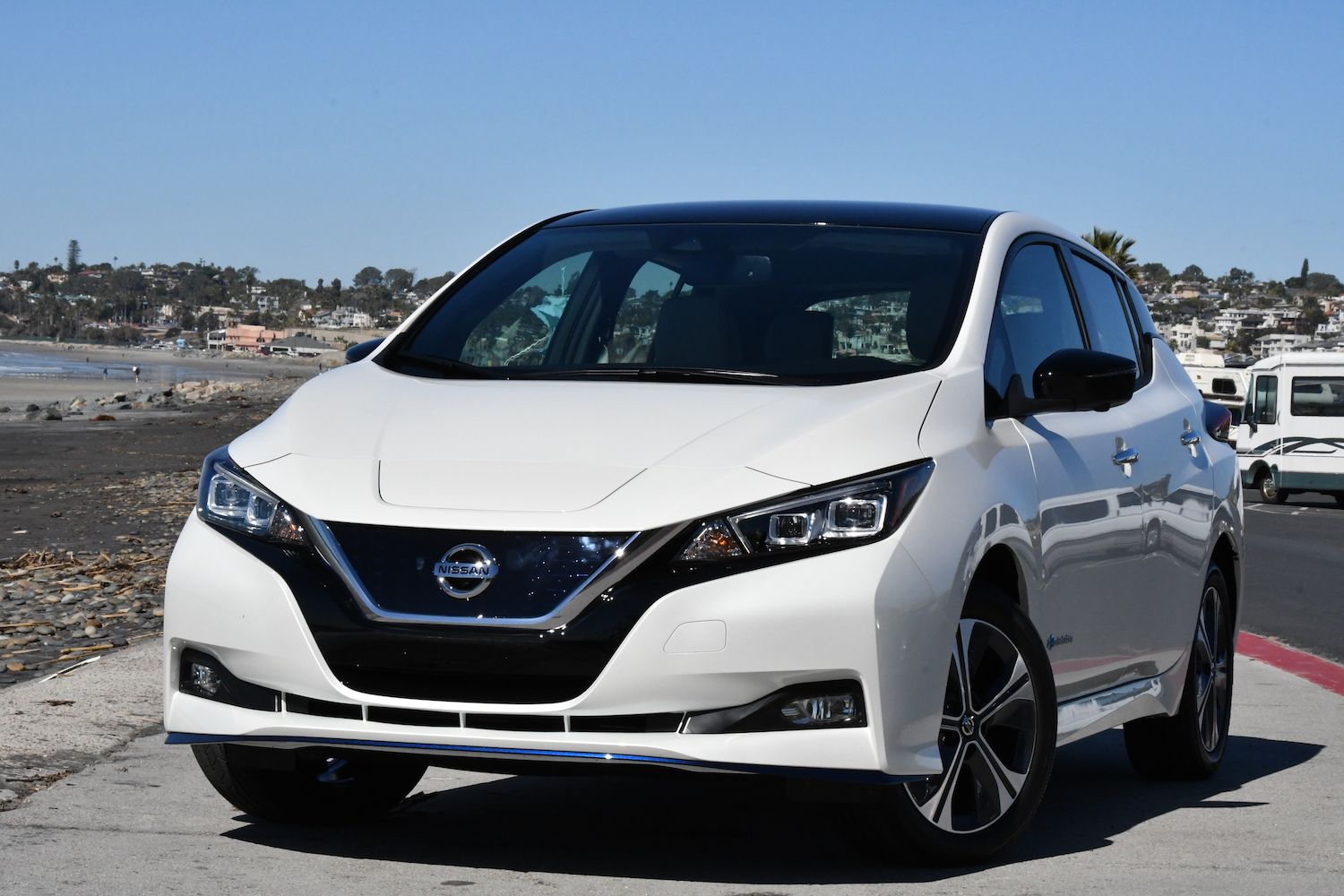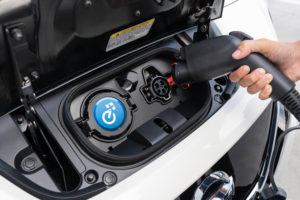The Best LEAF to Date
The 2019 LEAF Plus is the LEAF that we have all been waiting for. Introduced in 2011 the LEAF was the first mass-market all-electric vehicle and is still, despite other EV upstarts making gains, it’s still the best-selling electric car in history with over 300,000 sold worldwide. It’s won about every award for green automobiles, including the World Green Car award twice.
In 2018, Nissan delivered a fully updated and improved LEAF. Even though it was completely updated with a new body, running gear and new 40 kWh battery, it still left many wanting more range. For 2019 the LEAF Plus was introduced with increased range and a new and improved 62 kWh battery that features improved chemistry and durability. For 2019 the 40kWh LEAF is still offered along with the 62 kWh Leaf Plus.
Last year Green Fleet Report tested a 40kWh LEAF to see how it performed as a commute and as a long-distance runner. Overall, we were pleased with the ’18 LEAFs performance, but our road trip in the LEAF from Monterey Ca. to Lake Tahoe in the Sierra Nevada was still a challenge that required planning and careful driving.
This year we asked Nissan to provide us with a LEAF Plus so that we could make the same drive to Lake Tahoe to see if the 62kWh battery had improved the drive. The LEAF Plus is enhanced not only with a bigger, longer-range battery, but the electric motor is 46% more powerful with 214 horsepower and 251 pound-feet of torque. Fast Charging also gets a boost with the ability to charge at up to 100kW peak and 85 kW nominally.
The new LEAF Plus has an EPA range of between 215 to 226 miles depending on the trim level, which gives it membership in the 200+ mile club. The LEAF Plus’s pricing is also competitive starting at $36,500, and unlike the Bolt and Tesla Model 3, it still qualifies for the full $7500 federal tax credit. Throw in state, local, and utility incentives, plus Nissan’s dealer incentives and a LEAF Plus can easily end up costing under $25,000.
With its new, improved range and capabilities, Clean Fleet Reports wanted to see if the new LEAF Plus has improved enough that taking a weekend vacation of a few hundred miles would be as easy as taking the trip in a conventional ICE vehicle. Would it be up to the task, or would it face the same anxiety that the 40kWh LEAF trip had been?
With that challenge accepted by Nissan, we planned this year’s trip from the San Jose, California to Lake Tahoe nestled high in the Sierra Mountains, 242 miles away. This trip would range from sea level to over 7300 ft. and back down again. This trip was the same as we took last year in the 40kWh LEAF and would stress test the EV to the extreme, but was within the EPA range of the LEAF Plus.
Nissan provided a 2019 LEAF Plus SL complete with ProPilot Assist. As with last year’s trip, the route took advantage of the readily available DRIVEtheARC charging network that stretches between Monterey and Lake Tahoe.
DRIVEtheARC
While most Charging for an electric vehicle happens at home, public charging infrastructure is getting much better but is still a work in progress. Manufacturers like Tesla have invested heavily in inter-city charging networks with their proprietary SuperCharger network, but by and large industry standard networks like CHAdeMO and SAE DCFC networks are sparse to nonexistent outside of urban areas.
DRIVEtheARC is a pilot project funded by the New Energy and Industrial Technology Development Organization (NEDO), which is Japan’s most extensive public R&D management organization, the California Office of Business and Development, the California Energy Commission, and the California Air Resources Board.
In addition to the government partners, private industry participating partners include Nissan Motor Co., Kanematsu Corporation, and EVgo.
 California is the most significant market for plug-in electric vehicles in the US, and in Northern California, Monterey and Lake Tahoe are top weekend vacation destinations. DRIVEtheARC has installed 55 DCFC chargers on major highways between Monterey and Lake Tahoe and offers free charging to plug-in electric vehicles that utilize the CHAdeMO standard.
California is the most significant market for plug-in electric vehicles in the US, and in Northern California, Monterey and Lake Tahoe are top weekend vacation destinations. DRIVEtheARC has installed 55 DCFC chargers on major highways between Monterey and Lake Tahoe and offers free charging to plug-in electric vehicles that utilize the CHAdeMO standard.
The author and his wife have lived in the Bay Area for many years, and take several trips to Tahoe each year. They have a route that they always take and have great metrics for how long the trip takes in an ICE car, so the goal was to make their regular trip to Tahoe in the 19’ LEAF Plus and compare the experience to last year’s 40 kWh LEAF trip and previous trips in an ICE.
The itinerary was to start in San Jose, drive to Brentwood Ca. to pick up a friend who has a residence in Lake Tahoe, spend a few days in Tahoe, and then drive back. The route would take them on flat Interstates, secondary roads, past Sacramento to Placerville where they would stop for lunch, and then up Highway 50, which is a steep 7300-foot climb and then down into the 6200-foot elevation Lake Tahoe basin. The LEAF would carry 3 adults and all their luggage for a total of 242 miles.
The return trip would take them back downhill on Highway 50 and onto Interstate 5 and back home again. This segment was also 242 miles.
The entire round trip would be about 484 miles. One thing that would be different from their usual trip to the lake is that they would drive at the posted speed limits the entire trip.
And They’re Off
After L2 charging overnight, the next morning the LEAF set off to Lake Tahoe with 234 miles of indicated range. The first leg of the trip was on Interstate 680 and Interstate 580, which are relatively flat interstates. Next, the LEAF picked up our passenger in Brentwood Ca. and then traveled on rural roads to get onto Interstate 5 to Highway 50, where there was a stop for lunch in Placerville while the LEAF had its first QC at 175 miles. The day of the trip, there was one of the last Sierra Nevada storms of the season passing through, and temperatures were dropping fast. We started the day in 80-degree weather with a clear sky, but by the time we got to Placerville, the temperature had fallen to the mid 40’s with overcast and drizzle. Common sense said that it was prudent to get a 30-minute quick charge while we ate lunch. That was all it took to get us to our destination.
For the first part of the trip, speeds varied from 55 mph on the local roads to 70 mph on Interstate 5. This drive typically takes about 3 hours in an ICE, and surprisingly the LEAF pulled into the Placerville Quick charger at about the same time that for lunch that it takes in a regular ICE car. So far so good. The total distance of this leg was 175 miles. At this point, the LEAF Plus had bettered the trip from last year. One of the things that we all noticed was how quiet the LEAF Plus was at speed. Almost no road or wind noise, and definitely quieter than the 2018 LEAF. We just happened to have a sound meter app on the smartphone which showed the cabin sound was only 62dB at 65 mph, which is Rolls Royce quiet!
Lunch took about 40 minutes, and the LEAF finished its only quick charge on the uphill leg of the trip in about 30 minutes.
It’s interesting to note that in last year’s LEAF trip, after the lunchtime quick charge, the 40kWh’s battery temperature was quite a bit higher than it was before we quick charged. This year, the LEAF Plus’s temperature was rock steady in the middle of the gauge, and never moved from that the whole trip. The car charged up to 80% capacity in 30 minutes, so began the next leg on Highway 50, Placerville to Lake Tahoe, which is the most challenging part of the trip.
This part of the trip is 67 miles and has an elevation gain of about 700 ft. every 10 miles. The road starts off as a four-lane road with a speed limit of 55, and as Highway 50 increases in elevation, it becomes a narrow winding road that is much slower. Little did we know what was waiting for us on this last leg of the trip.
Up to the Sierra to the Lake
As the LEAF progressed up the grade, confidence increased. The LEAF stayed up with traffic, and by the looks on other drivers’ faces, they seemed surprised that this EV was holding its own on this mountain road.
The last part of Highway 50 to Lake Tahoe is the narrowest piece of the trip, and all of the traffic was much slower than the rest. The higher we went our confidence waned and the darker it became, with the drizzle soon turning to sleet, then to light snow, and finally into a blizzard with decreasing visibility.
 It took over an hour to travel the last 47 miles. During this part of the trip, ProPilot Assist stopped working with an error because its radar sensor was blocked with snow. The e-Pedal kept working, allowing one pedal driving, despite the heavy, slow traffic and limited visibility. This part of the trip was a bit of a white-knuckle experience mainly because the passengers were on the edge of their seats from the blizzard.
It took over an hour to travel the last 47 miles. During this part of the trip, ProPilot Assist stopped working with an error because its radar sensor was blocked with snow. The e-Pedal kept working, allowing one pedal driving, despite the heavy, slow traffic and limited visibility. This part of the trip was a bit of a white-knuckle experience mainly because the passengers were on the edge of their seats from the blizzard.
Finally, the LEAF Plus and its passengers arrived at the hotel in Lake Tahoe at about 5:30 p.m., which ended up being about an hour longer than the usual time driven in an ICE car. We were glad we arrived when we did because by the time we made it into the outskirts of Lake Tahoe we saw that chain control was in effect. Despite the road conditions and the Pro Pilot assist not working, the car remained stable and in control. With comfortable heated seats and an excellent heater, the cabin was warm and toasty on this last leg of the trip.
Enjoy the Lake
 The next morning the LEAF still had about 120 miles of range, and all was well. Because the DRIVEtheARC and the increased range of LEAF Plus, the total cost of the trip so far was $0.00!
The next morning the LEAF still had about 120 miles of range, and all was well. Because the DRIVEtheARC and the increased range of LEAF Plus, the total cost of the trip so far was $0.00!
With the remaining range we had we from charging in Placerville, we were able to drive around Tahoe for the rest of our stay without charging.
There is a saying in Lake Tahoe that “If you don’t like the weather today, just wait until tomorrow.” Sure enough, the next morning it was snowing early, but by 9 a.m., the storm had passed, the sun came out, and by noontime, all of the snow on the ground had melted with the lake looking spectacular.

The afternoon before our trip back, I visited the DRIVEtheARC DCQC in South Lake Tahoe to top off the battery. The charging stations are located at a Stop & Shop gas station which seems to be an excellent place for them. Granted there were only two DCQC stations for the twelve gas pumps, but I’m guessing that over time that ratio will be reversed. The DCQC session lasted 45 minutes and ended with a 90% charge. The next morning the LEAF Plus was topped off at the hotel’s destination charger, and we were ready to go.
The route home would take the LEAF Plus on the same picturesque route down Highway 50 to Sacramento, then on Interstate 5 to Brentwood, and then back to San Jose on Interstate 680.
Downhill Bound
The trip back was sunny and warm and was on a Thursday so we expected that it would be a pretty leisurely downhill drive, at least until we got into Sacramento. The indicated range on the LEAF was 247 miles when we left, so there was a chance that we might actually make it home on one charge, but we knew that there were several significant hills to cross in the “flatlands,” so it was going to be a challenge.

We started out with the Pro Pilot assist set at 55 mph for the first part of the drive on the narrow winding section of Highway 50, but at first, we were getting passed by all the pickups and SUVs of the locals, but as we drove further with Pro Pilot we were able to stay with the traffic. Pro Pilot Assist is one of the better L2 autonomous assist systems out there today, it is very smooth, with perfect acceleration and deceleration depending on the traffic. It never got confused like other L2 systems, jamming on the brakes, or flooring it when there was a clear space in traffic. Once we got to Sacramento and level roads, our miles/kWh had increased to 7.5 m/kWh compared to 3.2 kWh going up. Things were looking good that we might be able to make it home on one charge.
Our speed increased on the Interstate 5 to 70-75 mph, and when we arrived in Brentwood to drop our passenger off, the LEAF Plus still an energy economy of 6.2 m/kWh. The estimated range was down to 70 miles by then, and we still had two significant sets of hills to traverse and a total of 65 miles to go.
The LEAF Plus is alleged to keep about 10% of its battery capacity in reserve, but we haven’t had the chance to explore how much range is really left with the range estimate at zero. By the time we got to Livermore Ca. on Interstate 580, the indicated range and our remaining distance to home was too close to call, we decided to stop at a DRIVEtheARC DCQC and take 15 minutes of charge just to be safe.
One of the items we wanted to compare the LEAF Plus to the 2018 LEAF was how it behaved on long trips with multiple quick charges. The early 40kWh LEAFs had very conservative quick-charging profiles that throttled the charge rate and modestly increased charge times after several fast charges.
The 40kWh battery also ran hotter than what earlier LEAF batteries did, and that led to concerns by some owners that battery degradation would be accelerated.
Nissan updated the charging profiles on mid-2018 and later 40kWh LEAFs to be more aggressive, and several owners who monitor their 2018 LEAFs closely have reported that despite the battery running hotter, that degradation has actually been reduced over earlier versions of the LEAF battery.

During our time with the LEAF Plus, we found that with the faster DCQC port, charging sessions are more powerful and charge the battery more than with the earlier 40kWh LEAF. Multiple charging sessions over a short period are not throttled, and most interestingly, the battery temperature of the LEAF Plus 62kWh battery stay pretty much rock solid in the middle of the gauge regardless of how the car is driven or the number of quick charges. This is good news and really calls into question the whole active vs. passive cooling debate. While it is too early to assess the durability of the 62kWh LEAF Plus battery, the improvement of the 40kWh battery shows a positive trend.
After that brief stop, the LEAF Plus was off again and made it home safe with range to spare.
Lessons learned from this trip?
•While taking longer to come to market than everyone would have liked, the 2019 LEAF Plus is the best of LEAF to date.
•This trip proved that vacation and weekend trips of about 250 miles are very achievable with the 2019 LEAF Plus.
•With the 2019 LEAF Plus joining the 200+ mile club, range anxiety has become a thing of the past.
•In California, the DCFC networks are being built out quickly that make trips even in challenging terrains routine. As California goes, so goes the nation, which means that long-range travel in a BEV is on the cusp of being routine in other areas across the US too.
•The 2019 LEAF Plus performance during our Tahoe trip shows that you that can go the distance in a well-equipped BEV for around $36K or less.
•The rumor that LEAFs are not being able to endure multiple DCQC without excessive charge time slowdowns is entirely unfounded. The most significant challenge is that a larger battery can mean longer charge times regardless of the charge rate. The problem for all BEVs is that the larger the battery, the longer time it will take. As infrastructure and BEV charge rates increase, charging times will improve, but the laws of physics apply and the bigger the battery, the longer it will always take. The LEAF Plus can take advantage of the newer and faster DCQC units now coming online and without any charge throttling penalties.
• Now in its second year of availability, Nissan’s ProPilot Assist is a top-tier solution that offers the same services as all other Level 2 autonomous driving solutions from other automakers.
•The 2019 LEAF Plus is a compelling balance of range, quality, reliability, value, features, and cost that is competitive with any mainstream BEV on the market today.
Would Clean Fleet Reports recommend driving a LEAF cross-country?
As we said last year when we tested the 40kWh Leaf, no, we would not, but then again, we would not recommend driving any BEV cross-country unless the driver has the patience and courage to do so. Driving a BEV of any make today long distance is like the cross-country trips of the 1950s and 60s. It’s a leisurely trip that provides the opportunity to see the scenery and enjoy the countryside. It still requires planning, patience, and to expect the unexpected, but it is fast becoming more mainstream. If your goal is to drive a long distance quickly, then drive an ICE hybrid, or better yet fly.
Even with the Tesla SuperCharger network currently being the most extensive, the national BEV charging infrastructure is still not there, but with the new charging infrastructure rapidly coming online, things are improving daily.
However, for vacation and weekend trips around 500 miles roundtrip on major highways and urban areas, the LEAF Plus is an excellent safe choice, and as a daily driver commuter car, the 2019 LEAF Plus is still the best choice of any BEV on the market today.


